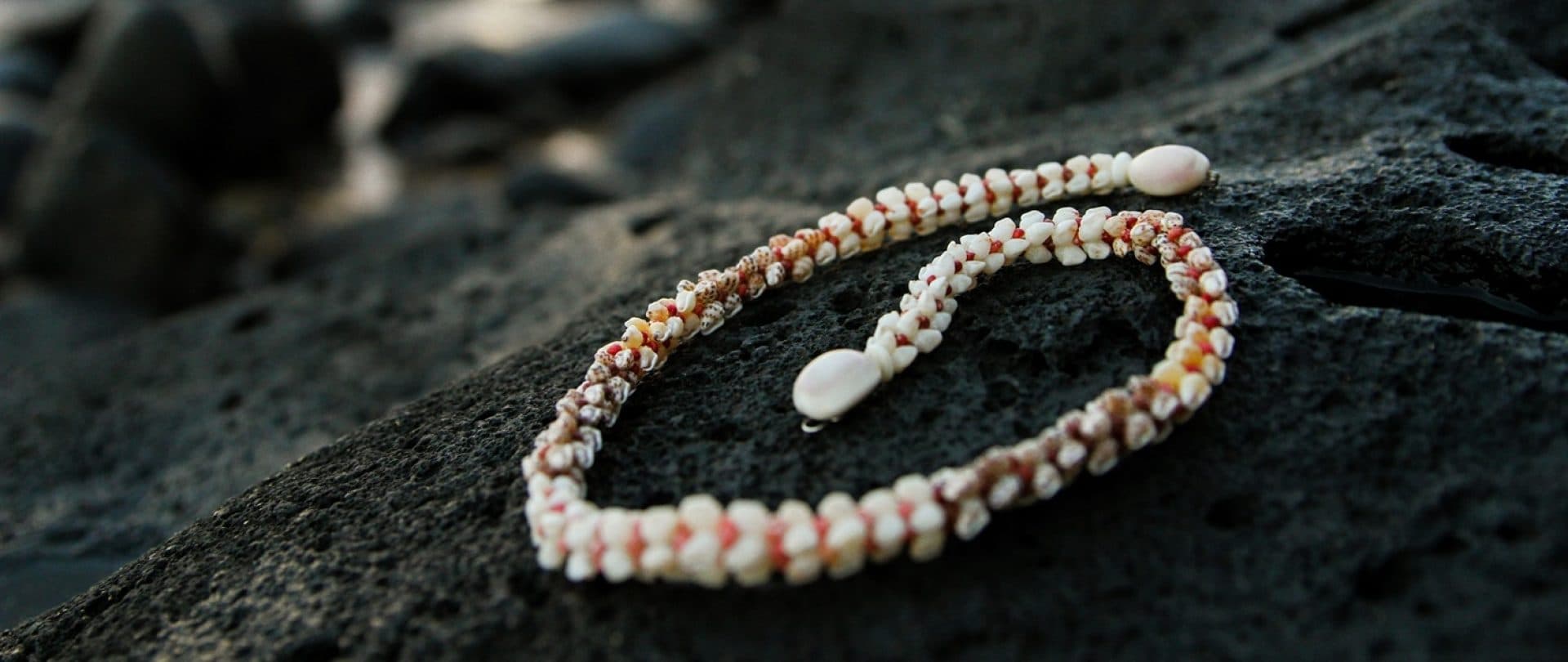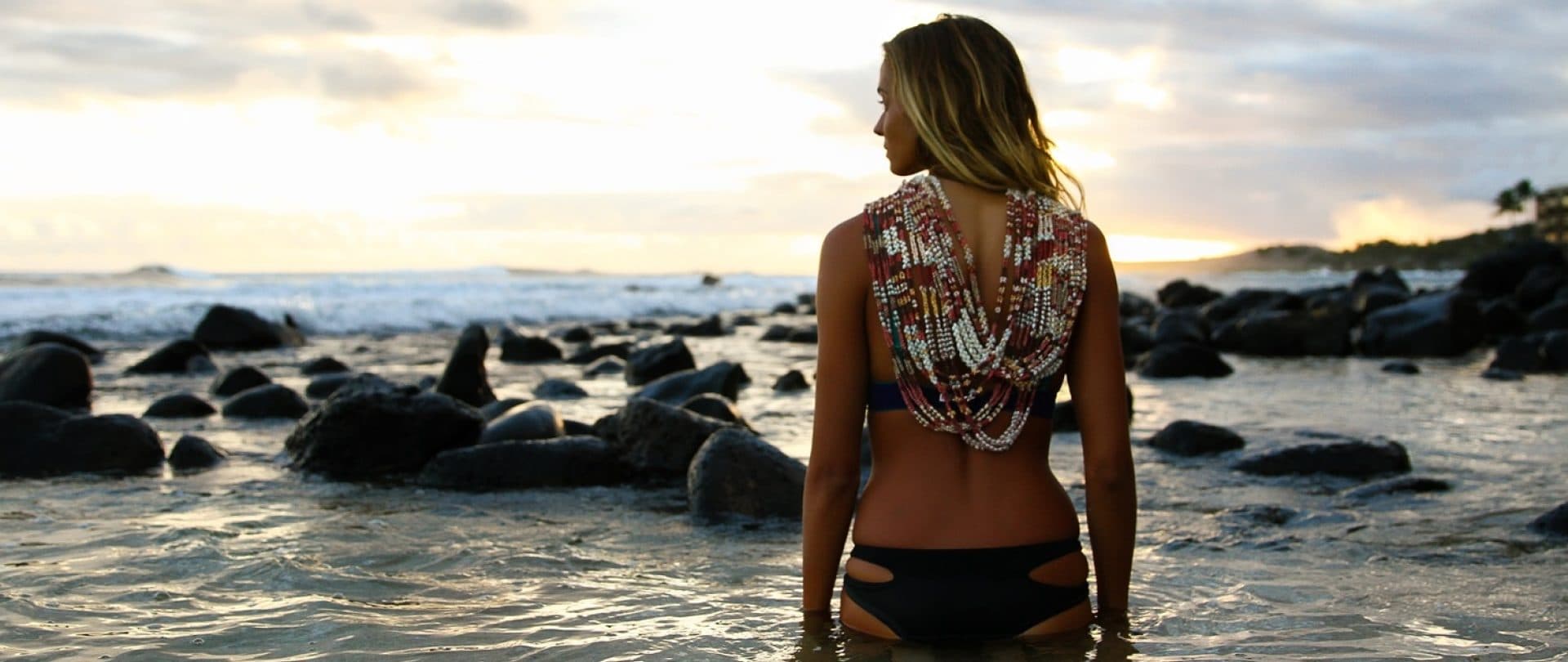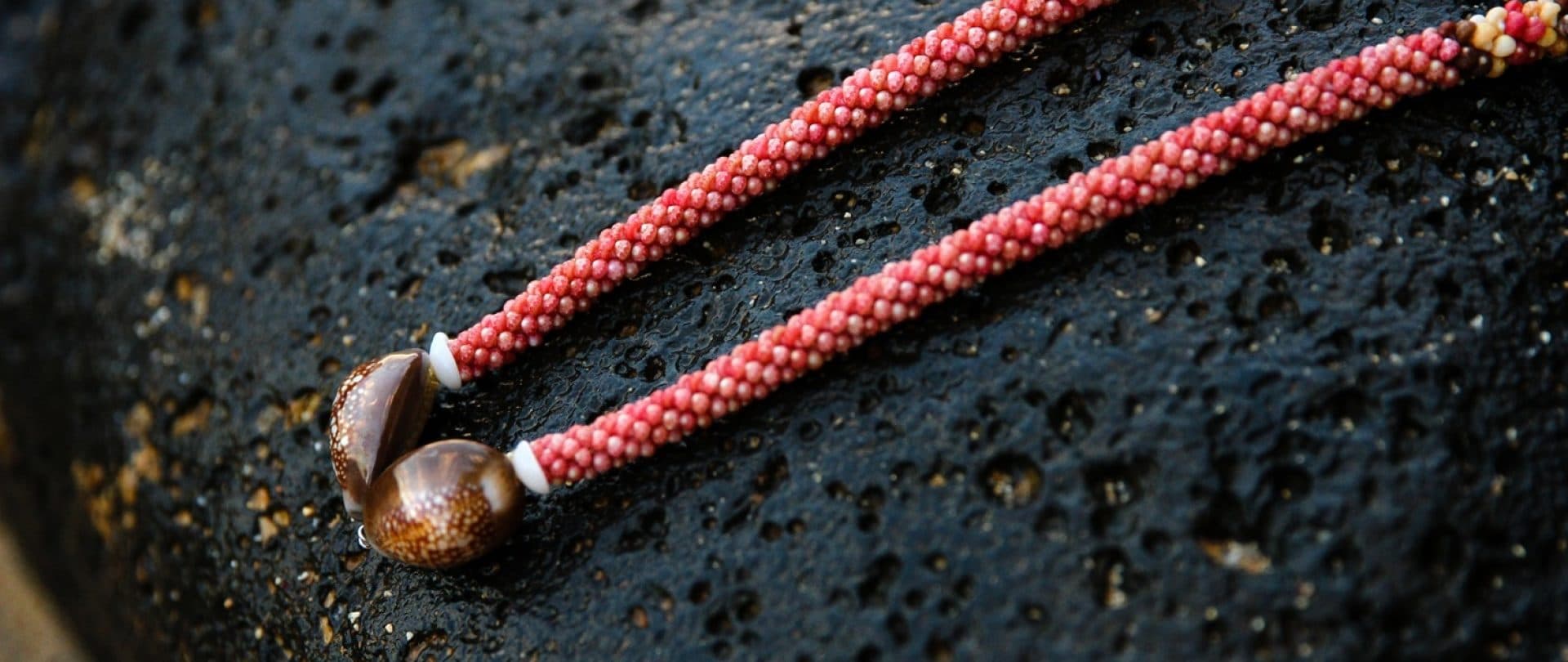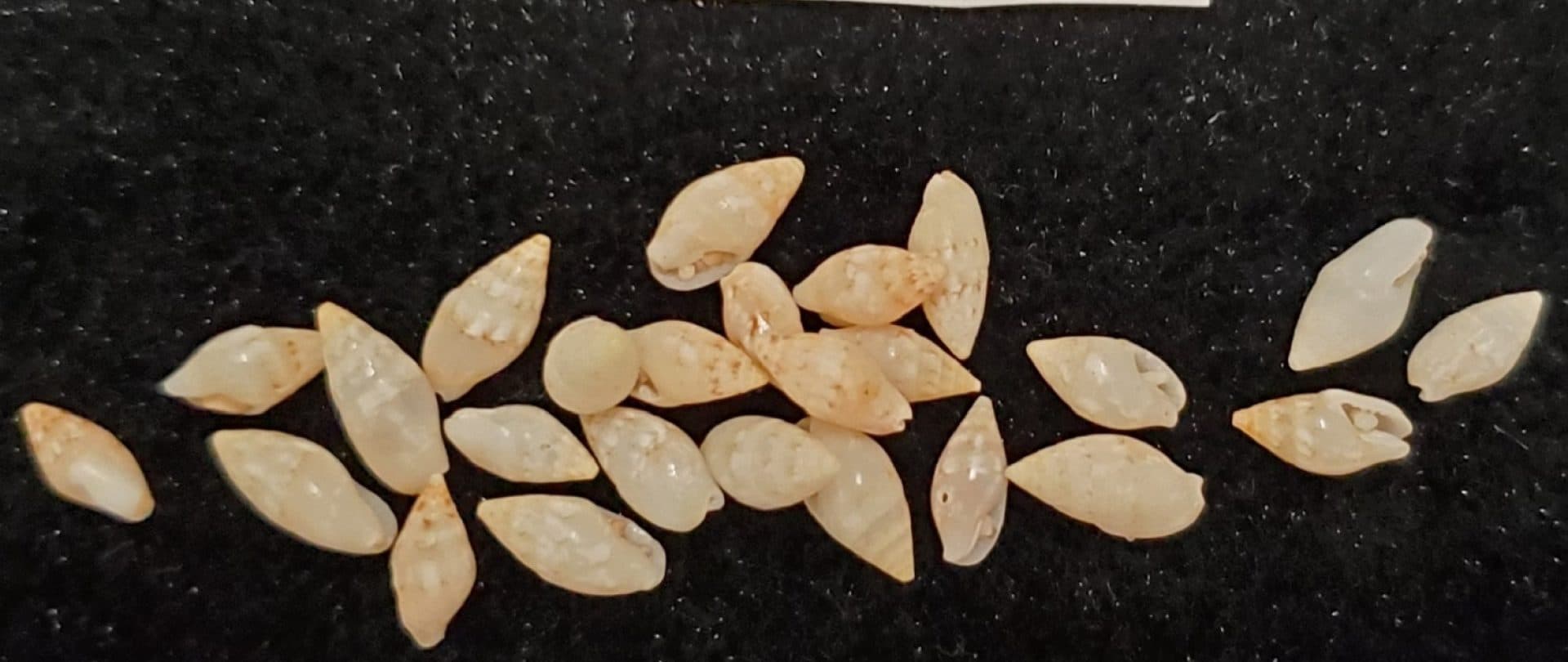Ocean Gems
The treasured Ni‘ihau shell lei
BY Krystal Kakimoto
On a tiny island in the middle of the Pacific Ocean lies the legendary island of Ni‘ihau. Shrouded in mystery and steeped in tradition, the island is known as “the Forbidden Isle” because it is off-limits for outsiders to visit. For generations, people have wondered about this untouched paradise and how time has seemingly stood still. Yet, one of its greatest wonders is the exquisite lei pūpū (Ni‘ihau shell lei) produced on the island—delicate, handcrafted masterpieces often called the “diamonds of Hawai‘i.” The rare adornments are not just jewelry; they are symbols of Ni‘ihau’s deep cultural heritage and are as mesmerizing as the island itself.
Ni‘ihau is the westernmost island in the Hawaiian chain, located 17.5 miles southwest of Kaua‘i across the Kaulakahi Channel. The island was purchased in 1864 by Elizabeth Sinclair, a Scottish homemaker and plantation owner in New Zealand, for $10,000 from the Kingdom of Hawai‘i. Sinclair, who was 64 years old at the time of the purchase, passed the private ownership of the island to her descendants, the Robinsons. To this day, the Robinson family has maintained ownership and control of the island, prohibiting access to outsiders to protect the island’s ecosystem and cultural heritage.
Today, roughly 100 native Hawaiians continue to call Ni‘ihau home. There is a fluctuation in the number of residents due to people leaving the island for school, medical treatments, or to seek employment. The only inhabitable village is Pu‘uwai, located on the island's western coast. There are no paved roads, hospitals, power lines, police stations, or grocery stores on the island. Most residents live on a subsistence lifestyle, relying on hunting, fishing, and farming, with other supplies brought in via helicopter or boat. Ni'ihau Ranch once employed many residents, which the Robinson family ran until its closure in 1999. A large amount of Ni‘ihau’s income comes from a small Navy installation on one of the 1,300-foot-high cliffs. In addition, selling Ni‘ihau shell jewelry is another source of income for many households.
For centuries, the tiny pūpū (shells) have been collected and strung together by Ni‘ihauans. Archaeological evidence confirms that the shells have been pierced, strung, and used for ornamental decoration for centuries. The earliest recorded writings, which mention Ni‘ihau shell lei, come from the voyages of Captain James Cook, who visited the island in 1778 and 1779 in search of fresh water and food. He and his crew interacted with the people of Ni‘ihau, who welcomed them with traditional ceremonies and exchanges of gifts. During this time, Cook noted the intricate shell jewelry the native Hawaiians wore, even returning home to Britain with a few pieces of the treasured lei in his possession. The allure of Ni‘ihau shell lei continued to grow on an international level in 1887 when Queen Kapi‘olani, en route to attend Queen Victoria’s Jubilee, had studio portraits taken in which she wore a multi-strand lei of ivory-colored Ni‘ihau shells, which created quite the sensation in London upon her arrival.
Creating a Ni‘ihau shell lei is a lengthy process, taking months or even years to complete. The first step is collecting the miniature shells, some of which are as small as a pinhead. While women typically create the shell lei, the entire family can be involved in collecting the shells. On a collection day, the household usually wakes up early and checks the weather. If conditions are favorable, food and water are packed along with resealable plastic bags or glass jars to store collected shells. After walking, biking, or horseback riding to the beach, the shoreline is visually inspected to identify where the shells have been deposited. Then, family members settle down in their areas to meticulously search for shells. Not every shell is taken—broken or flawed shells are discarded, with only whole, intact shells being collected. While you can spot shells year-round on the beach, the best time of year to collect shells is in the winter months because the storms and big surf churn the sand, making it easier to find them.
After a long day of collecting, the next step is to allow the shells to dry for a few days before sorting them based on type, size, color, and intensity. The shells are then prepared for stringing by removing the grains of sand, in some cases, and drilling pukas (holes) into the shells, depending on the style of lei the artisan intends to make. At this point, the work shifts primarily to women who have passed on the skill of crafting Ni‘ihau shell lei from generation to generation.
Due to the rarity of genuine Ni‘ihau shells, the skill needed to create a lei and the lofty price tags associated, the Hawai‘i State House of Representatives approved H.B. 2569 in 2004 which prohibits the selling of “seashell items” labeled from Ni‘ihau unless 100% of the shells come from the island and the lei is made in Hawai‘i. Three shells are commonly used to create Ni‘ihau shell lei—kahelelani, momi, and lāiki. Kahelelani (Collonista verruca) are the smallest Ni‘ihau shells, measuring about three millimeters in diameter. Named in honor of the island’s first chief, the rounded-topped shells come in a rainbow of colors ranging from white, burgundy, and yellow, with the rarest colors being black and hot pink. Momi (Euplica varians) is the most commonly seen Ni‘ihau shell. Translating to “pearl,” momi shells are often pure white and known for their highly lustrous nature. Other types of momi shells can be brown, gold, or blue with striped or spotted patterns. Lāiki shells (Graphicomassa margarita) are also known as “rice shells” because they resemble a single grain of polished white rice. These are the simplest Ni‘ihau shells to string and are often used to create long single-strand lei.
Ni'ihau shells can be made into distinctive lei styles based on the type of shells collected or the artisan’s inspiration. The simplest style is a kui pololei, meaning “straight strung.” The shells are strung end-to-end in this style, creating a continuous single-strand lei. You will often see lāiki or momi shells used to make this style of lei. There is also the pikake style of lei, where momi shells are strung along two strings, with a knot tied between each shell. The maunaloa style is another type of straight-stringing lei, but this variation uses kahelelani shells, which are strung alternating through and flattened. The poepoe style is a stunning lei, created with shells tightly wrapped in a rope-like pattern. Artisans employ numerous other patterns, but one incredibly special style is called the Kipona, in which multiple styles and shells are combined to create a single lei, showcasing the creator’s unique vision and skill.
For Liz Cope, renowned for her expertise in Ni‘ihau shell lei, much of her work at Hawaiian Trading Post focuses on educating people about Ni‘ihau shell lei, helping them appreciate the skill and tradition behind each lei while supporting Ni‘ihau artisans. “I grew up with Ni‘ihauans on Kaua‘i’s west side. I developed friendships with them and, over time, began purchasing Ni‘ihau shell lei from them,” says Cope. Part of the mother-daughter duo behind Hawaiian Trading Post, Cope is one of the few people on the island of Kaua‘i offering 100% Ni‘ihau shell lei, bracelets, earrings, pendants, and custom pieces. “Many places offer 80% Ni‘ihau shells mixed in with shells from other areas. We deal only with 100% Ni‘ihau shells, and each lei has a printed certificate of authenticity. I make it a point to educate buyers on the difference between shells from Ni‘ihau, Maui or Kaua‘i. Only Ni‘ihau shells will have an innate luster.”
When purchasing a Ni‘ihau shell lei, Cope points out that knowing where the shells come from is essential, so you are not exploited. Additional points to keep in mind are the color of the shells, ensuring that if you are purchasing a monochromatic color lei, all the shells are the same color. Also, inspect the shells for flaws, such as cracks, chips, or holes that the lei maker may have overlooked. Symmetry is also something to consider, ensuring that each side of the lei matches. Finally, you need to inspect the workmanship, ensuring that the knots are tightly tied, holes are punched into each shell at the same spot, and the grains of sand have been removed from the shell, except in certain styles of lei.
Each lei purchased at Hawaiian Trading Post is carefully padded and boxed, ensuring the lei is prepared for travel. Once home, it is recommended that you store your lei in cloth or tissue paper, then wrap the lei in a plastic container or box with a lid, rather than a plastic bag. The shells will absorb dirt and oils, so it is recommended not to get makeup, fragrance, or lotion on the shells. If your lei needs cleaning, use a mild soap mixed with lukewarm water to clean the lei gently, then let it air dry thoroughly.
While on the island of Kaua‘i, you can view Ni‘ihau shell lei on display at the Kaua‘i Museum. In their cultural heritage exhibit, guests to the museum can view rare, handmade lei from the island of Ni‘ihau. From the brilliant momi shells luminously glowing to intricately strung kahelelani (turban shell) chokers, the lei on display exemplify some of the finest Ni‘ihau shell lei in the world.
Ni‘ihau shell lei are more than beautiful adornments, they are masterpieces of skill, patience and cultural pride. Cope explains, “The people of Ni‘ihau have been working with the shells and making lei for centuries. Ni‘ihau shell lei is one of the most beautiful arts you can imagine, and it reflects the time and care that was put into creating each lei.” With their gem-like rarity and value, Ni‘ihau shell lei are treasured family heirlooms meant to be passed down through generations, preserving both their beauty and the legacy of the artisans who craft them.
Hawaiian Trading Post; 3427 Kōloa Road, Kalāheo; (808) 332-7404; hawaiiantradingpostkauai.com; Open Monday through Friday from 10:30 a.m. to 4:00 p.m.
Kaua‘i Museum, 4428 Rice Street, Līhu‘e; (808) 245-6931; kauaimuseum.org; Open Monday through Friday from 9 a.m. to 4 p.m. and Saturday from 9 a.m. to 2 p.m.




